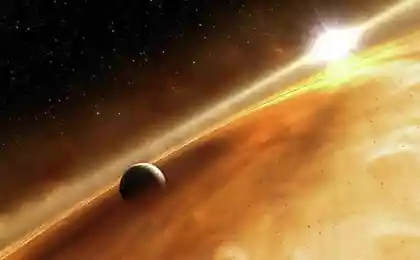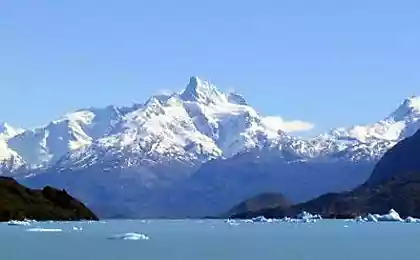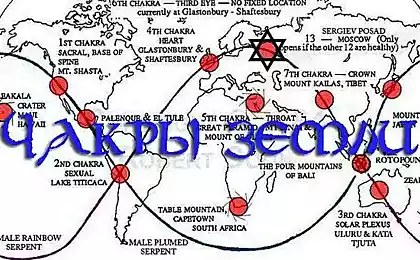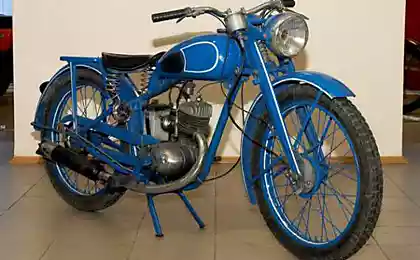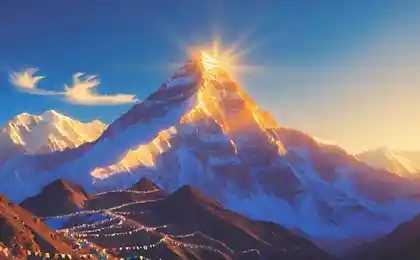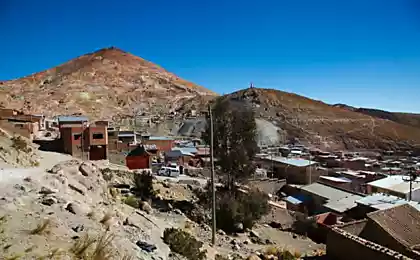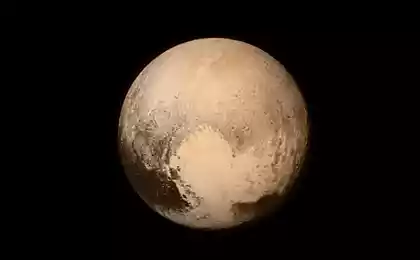359
The extraordinary beauty of Mount Kilimanjaro in Tanzania
In the northeast of Tanzania, among the desert plains is the highest point in Africa - the majestic volcano Kilimanjaro (5,895 m). It rises above the Maasai plateau, lying at an altitude of 900 meters above sea level.
The top of the dormant volcano is covered with a snow-white cap of snow, which sparkles impressively in the rays of the bright African sun. Perhaps that is why the local population gave it such a name – Kilimanjaro, which means “shining mountain” in Swahili. In ancient times, the tribes that inhabited the area, who had never seen snow, were sure that it was covered with silver. But they did not dare to test their assumptions for a long time, since many frightening legends were associated with the volcano, telling about evil spirits that lived on the top of Kilimanjaro and guarding its treasures. And yet after some time, the local leader sent a small detachment of the most courageous warriors to conquer the mysterious peak. Upon arrival, they immediately undertook to explore the “silver” lying everywhere, but it, to everyone’s surprise, instantly melted in their hands. On the "shining mountain" there was nothing but eternal cold snow. Then the aborigines, feeling the cold of a silver ice cap, gave the giant volcano another name - "Abode of the god of cold".
There are many legends associated with Kilimanjaro. Locals believe that the top of the volcano is inhabited by gods, and the caves and ravines of the mountain are inhabited by pygmies who are engaged in hunting and gathering. Weather conditions, according to local beliefs, are associated with the mood of evil spirits living on the mountain.
The beauty of the top of Kilimanjaro can be seen for miles around the surrounding Tanzanian and Kenyan savannahs. Its outlines are sloping slopes rising to an oblong, flat top, which is actually a giant 2-kilometer caldera - a vast basin at the peak of the volcano.
On very hot days, you can contemplate a fantastic picture: from afar, the bluish base of the mountain becomes almost indistinguishable against the background of the savannah, and it seems that the top covered with snow hovers in the air. And soaring clouds, often flying below the snow cap, amplify this effect.
The first mention of huge snow-capped mountains falls on the II century AD. They were plotted on the geographical map of Ptolemy. However, the official date of the discovery of the “shining mountain” is considered to be May 11, 1848, when it first appeared before the eyes of the German pastor Johannes Rebman. Since 1861, attempts to conquer the summit began: in the same year, the height of 2,500 meters was conquered, in 1862 - 4200 meters, and in 1883-1884 and 1887 a point located at an altitude of 5270 meters was reached. All these climbs were made by the Hungarian count Samuel Teleki. Already in October 1889, the German traveler Hans Meyer, in company with the Australian mountaineer Ludwig Purtscheller, managed to reach the summit of Kilimanjaro.
Kilimanjaro is a dormant volcano of almost conical shape, consisting of multiple layers of tephra, hardened lava and volcanic ash. According to scientists, it was formed due to several volcanic movements more than a million years ago. It includes three main peaks, also extinct volcanoes: Shira (3,962 m), located in the west, Mawenzi (5,149 m) - in the east, and in the central part is the youngest and highest volcano - Kibo (5,895 m), on which lie multiple cascades of ice terraces. Uhuru Peak, located on the edge of Kibo crater, is the highest point of Kilimanjaro and all of Africa.
Kibo volcano:
There were no documented eruptions at Kilimanjaro, but according to local legends, the last major volcanic activity was observed about 150,000-200,000 years ago. As a result of research conducted in 2003, scientists found the presence of lava just 400 meters under the crater of the highest peak of Kilimanjaro – Kibo. Although no negative predictions about volcanic activity have been made, gas emissions regularly occur at the top of the volcano, which could lead to its collapse, which in turn would cause a major eruption. In the past, Kibo has experienced several landslides and landslides that have formed an area known as the “western breach.” Today, there is much talk about global warming, contributing to the fact that the famous Kilimanjar glaciers are rapidly melting.
Scientists explain this phenomenon not by global warming, but by falling levels of daily precipitation, which are necessary to restore the glacial mass. Some researchers believe that the volcano wakes up, resulting in its heating and, as a result, the melting of the ice cap. Over the past 100 years, the amount of ice and snow covering Kilimanjaro has decreased by more than 80%. In 2005, for the first time in 11,000 years, they melted almost completely. At the current rate, the disappearance of Kilimanjaro snow is expected to occur between 2022 and 2033. Kilimanjaro glacier in 2007. :
Kilimanjaro in 2012 View from above:
The area occupied by the volcano is 64 km wide and 97 km long. Such a huge size allows Kilimanjaro to form its own climate. At an altitude of about 4000 meters above sea level, you can find numerous small streams and rivers born in glaciers, which carry life-giving moisture to pastures and fields.
The flora and fauna of Kilimanjaro is extremely rich and diverse. In the lower part of the mountain, which at an altitude of up to 1000 meters, there are savannas inhabited by monkeys, leopards, servals and honey badgers. Interestingly, on the lower slopes of the mountain grow coffee plantations and banana groves, there are crops of corn. At an altitude of 1800 meters, the ownership of moist equatorial forests begins.
The territory, located at an altitude of 2800-4000 meters, is covered by mountain swamps and meadows strewn with colorful flowers.
Here you can find such animals as giraffes, elephants, lions, as well as some rodents.
Starting at 4400 meters, closer to the top, begins the kingdom of the mountain desert, where only high-altitude lichens and mosses survive.
Above is a world of cold snow where only cold rock and ice can be seen.
Kilimanjaro Glacier at an altitude of 5800 meters:
On the lower slopes of Kilimanjaro live Chaga mountaineers, engaged, like their ancient ancestors, agriculture. They grow coffee and banana plantations in the local warm and moderately humid climate.
The territory of Kilimanjaro has the status of a National Park, which in 1987 was included in the UNESCO World Heritage List.
The conquest of the top of Kilimanjaro for many years has been very popular among outdoor enthusiasts. Today there are several tourist routes. The most popular among them is Marangu or the Coca-Cola Route, which tourists overcome in 5-6 days. Significantly simplifies the task of the presence of mountain shelters, removing the need to throw tents. The "Whiskey Route" or Machame is the most beautiful route, the duration of which is slightly longer than the previous one - 6-7 days. The northern slope of the mountain has only one path – Rongai. On average, it is overcome by tourists in 5-6 days. The longest western route is through the Shira Plateau (5-6 days). The Umbwe route is one of the most difficult – it runs through the dense jungle, which requires some physical training. During the conquest of Kilimanjaro, many tourists need to adapt to the mountain climate and avoid mountain sickness.
Among the conquerors of the summit of Kilimanjaro have their record holders. In 2001, an Italian named Bruno Brunod crossed the Marangu route in just five and a half hours. In 2004, Simon Mtuy, a native of Tanzania, climbed the Umbwe Trail in just 8 hours and 27 minutes and descended to the Mwek Passage. The Tanzanian did not stop there and two years later he walked the Umbwe trail back and forth in 9 hours and 19 minutes. The first female record belongs to the Englishwoman Rebecca Rees-Evans, her result of climbing the peak of Kilimanjaro is 13 hours and 16 minutes. The youngest conqueror of the huge volcano is American Keats Boyd, who conquered the summit at the age of seven.
The majestic volcano of Kilimanjaro was a muse for many creative personalities - books were written about it, films were shot, songs were dedicated to it. Among the most famous literary works that mention the African giant are Ernest Hemingway’s Snow of Kilimanjaro (1936), Ray Bradbury’s The Machine to Kilimanjaro (1965), and Olga Larionova’s Leopard from the Top of Kilimanjaro (1965).
According to the book “Snow of Kilimanjaro” in 1952, Henry King made the film of the same name. The famous volcano can be seen in the fantastic film Independence Day (1996) and in the film Lara Croft Tomb Raider: Cradle of Life (2003).
To get to Mount Kilimanjaro, you first need to get to the largest city in Tanzania - Dar es Salaam. The next target is the city of Moshi, located at the foot of the volcano. The distance from Dar es Salaam to Moshi is 560-600 km, which is best overcome by bus departing in the early morning to reach the final destination before the night. In the town there are many cozy hotels that convey all the local flavor. You can get to the mountain only with a special permit, which will help to arrange any of the travel agencies that exist in abundance in Moshi. There, tourists are helped to organize the climb, finding the right route, choosing a guide and time. Moshi can also be reached from the capital of Kenya, Nairobi, which is 290 km away.
Source:udivitelno.com
The top of the dormant volcano is covered with a snow-white cap of snow, which sparkles impressively in the rays of the bright African sun. Perhaps that is why the local population gave it such a name – Kilimanjaro, which means “shining mountain” in Swahili. In ancient times, the tribes that inhabited the area, who had never seen snow, were sure that it was covered with silver. But they did not dare to test their assumptions for a long time, since many frightening legends were associated with the volcano, telling about evil spirits that lived on the top of Kilimanjaro and guarding its treasures. And yet after some time, the local leader sent a small detachment of the most courageous warriors to conquer the mysterious peak. Upon arrival, they immediately undertook to explore the “silver” lying everywhere, but it, to everyone’s surprise, instantly melted in their hands. On the "shining mountain" there was nothing but eternal cold snow. Then the aborigines, feeling the cold of a silver ice cap, gave the giant volcano another name - "Abode of the god of cold".
There are many legends associated with Kilimanjaro. Locals believe that the top of the volcano is inhabited by gods, and the caves and ravines of the mountain are inhabited by pygmies who are engaged in hunting and gathering. Weather conditions, according to local beliefs, are associated with the mood of evil spirits living on the mountain.
The beauty of the top of Kilimanjaro can be seen for miles around the surrounding Tanzanian and Kenyan savannahs. Its outlines are sloping slopes rising to an oblong, flat top, which is actually a giant 2-kilometer caldera - a vast basin at the peak of the volcano.
On very hot days, you can contemplate a fantastic picture: from afar, the bluish base of the mountain becomes almost indistinguishable against the background of the savannah, and it seems that the top covered with snow hovers in the air. And soaring clouds, often flying below the snow cap, amplify this effect.
The first mention of huge snow-capped mountains falls on the II century AD. They were plotted on the geographical map of Ptolemy. However, the official date of the discovery of the “shining mountain” is considered to be May 11, 1848, when it first appeared before the eyes of the German pastor Johannes Rebman. Since 1861, attempts to conquer the summit began: in the same year, the height of 2,500 meters was conquered, in 1862 - 4200 meters, and in 1883-1884 and 1887 a point located at an altitude of 5270 meters was reached. All these climbs were made by the Hungarian count Samuel Teleki. Already in October 1889, the German traveler Hans Meyer, in company with the Australian mountaineer Ludwig Purtscheller, managed to reach the summit of Kilimanjaro.
Kilimanjaro is a dormant volcano of almost conical shape, consisting of multiple layers of tephra, hardened lava and volcanic ash. According to scientists, it was formed due to several volcanic movements more than a million years ago. It includes three main peaks, also extinct volcanoes: Shira (3,962 m), located in the west, Mawenzi (5,149 m) - in the east, and in the central part is the youngest and highest volcano - Kibo (5,895 m), on which lie multiple cascades of ice terraces. Uhuru Peak, located on the edge of Kibo crater, is the highest point of Kilimanjaro and all of Africa.
Kibo volcano:
There were no documented eruptions at Kilimanjaro, but according to local legends, the last major volcanic activity was observed about 150,000-200,000 years ago. As a result of research conducted in 2003, scientists found the presence of lava just 400 meters under the crater of the highest peak of Kilimanjaro – Kibo. Although no negative predictions about volcanic activity have been made, gas emissions regularly occur at the top of the volcano, which could lead to its collapse, which in turn would cause a major eruption. In the past, Kibo has experienced several landslides and landslides that have formed an area known as the “western breach.” Today, there is much talk about global warming, contributing to the fact that the famous Kilimanjar glaciers are rapidly melting.
Scientists explain this phenomenon not by global warming, but by falling levels of daily precipitation, which are necessary to restore the glacial mass. Some researchers believe that the volcano wakes up, resulting in its heating and, as a result, the melting of the ice cap. Over the past 100 years, the amount of ice and snow covering Kilimanjaro has decreased by more than 80%. In 2005, for the first time in 11,000 years, they melted almost completely. At the current rate, the disappearance of Kilimanjaro snow is expected to occur between 2022 and 2033. Kilimanjaro glacier in 2007. :
Kilimanjaro in 2012 View from above:
The area occupied by the volcano is 64 km wide and 97 km long. Such a huge size allows Kilimanjaro to form its own climate. At an altitude of about 4000 meters above sea level, you can find numerous small streams and rivers born in glaciers, which carry life-giving moisture to pastures and fields.
The flora and fauna of Kilimanjaro is extremely rich and diverse. In the lower part of the mountain, which at an altitude of up to 1000 meters, there are savannas inhabited by monkeys, leopards, servals and honey badgers. Interestingly, on the lower slopes of the mountain grow coffee plantations and banana groves, there are crops of corn. At an altitude of 1800 meters, the ownership of moist equatorial forests begins.
The territory, located at an altitude of 2800-4000 meters, is covered by mountain swamps and meadows strewn with colorful flowers.
Here you can find such animals as giraffes, elephants, lions, as well as some rodents.
Starting at 4400 meters, closer to the top, begins the kingdom of the mountain desert, where only high-altitude lichens and mosses survive.
Above is a world of cold snow where only cold rock and ice can be seen.
Kilimanjaro Glacier at an altitude of 5800 meters:
On the lower slopes of Kilimanjaro live Chaga mountaineers, engaged, like their ancient ancestors, agriculture. They grow coffee and banana plantations in the local warm and moderately humid climate.
The territory of Kilimanjaro has the status of a National Park, which in 1987 was included in the UNESCO World Heritage List.
The conquest of the top of Kilimanjaro for many years has been very popular among outdoor enthusiasts. Today there are several tourist routes. The most popular among them is Marangu or the Coca-Cola Route, which tourists overcome in 5-6 days. Significantly simplifies the task of the presence of mountain shelters, removing the need to throw tents. The "Whiskey Route" or Machame is the most beautiful route, the duration of which is slightly longer than the previous one - 6-7 days. The northern slope of the mountain has only one path – Rongai. On average, it is overcome by tourists in 5-6 days. The longest western route is through the Shira Plateau (5-6 days). The Umbwe route is one of the most difficult – it runs through the dense jungle, which requires some physical training. During the conquest of Kilimanjaro, many tourists need to adapt to the mountain climate and avoid mountain sickness.
Among the conquerors of the summit of Kilimanjaro have their record holders. In 2001, an Italian named Bruno Brunod crossed the Marangu route in just five and a half hours. In 2004, Simon Mtuy, a native of Tanzania, climbed the Umbwe Trail in just 8 hours and 27 minutes and descended to the Mwek Passage. The Tanzanian did not stop there and two years later he walked the Umbwe trail back and forth in 9 hours and 19 minutes. The first female record belongs to the Englishwoman Rebecca Rees-Evans, her result of climbing the peak of Kilimanjaro is 13 hours and 16 minutes. The youngest conqueror of the huge volcano is American Keats Boyd, who conquered the summit at the age of seven.
The majestic volcano of Kilimanjaro was a muse for many creative personalities - books were written about it, films were shot, songs were dedicated to it. Among the most famous literary works that mention the African giant are Ernest Hemingway’s Snow of Kilimanjaro (1936), Ray Bradbury’s The Machine to Kilimanjaro (1965), and Olga Larionova’s Leopard from the Top of Kilimanjaro (1965).
According to the book “Snow of Kilimanjaro” in 1952, Henry King made the film of the same name. The famous volcano can be seen in the fantastic film Independence Day (1996) and in the film Lara Croft Tomb Raider: Cradle of Life (2003).
To get to Mount Kilimanjaro, you first need to get to the largest city in Tanzania - Dar es Salaam. The next target is the city of Moshi, located at the foot of the volcano. The distance from Dar es Salaam to Moshi is 560-600 km, which is best overcome by bus departing in the early morning to reach the final destination before the night. In the town there are many cozy hotels that convey all the local flavor. You can get to the mountain only with a special permit, which will help to arrange any of the travel agencies that exist in abundance in Moshi. There, tourists are helped to organize the climb, finding the right route, choosing a guide and time. Moshi can also be reached from the capital of Kenya, Nairobi, which is 290 km away.
Source:udivitelno.com











